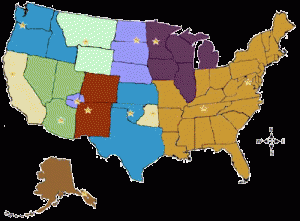Indian Tribes of the Western Region
The Western Regional Office, located in Phoenix Arizona has a service population of approximately 143,000 American Indian people enrolled in forty-two tribes. It is responsible for 12,800,000 acres primarily in the states of Arizona, Nevada and Utah. Portions of it are also in California, Oregon and Idaho. Fourteen Agencies are directed by the Western Regional Office. A swift overview of the Region’s tribes include the O’odham, Yaqui, Yuman and Pai Tribes of Arizona’s low and mid deserts and Grand Canyon, and the Apache of the mid-deserts and mountain forests. The Hopi live on Arizona’s Colorado Plateau mesas. Nevada has many … Read more

